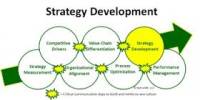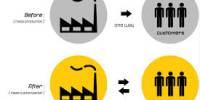EXECUTIVE SUMMARY
This report conveys our analysis and findings of the marketing research project that was conducted on Product Line Extension of Southeast Bank Limited. The various requirements for conducting the research as briefed in the lecture was exclusively followed while performing the research analysis and writing the report.
Southeast Bank has not been able to increase its market share sufficiently and we believed that its limited product offerings was the primary reason for its low market share. In addition we believed that opening new bank branches outside Dhaka would also enhance the bank’s market share. We therefore performed in-depth research to test the validity of our assumptions.
We conducted exploratory research through having discussions with Southeast Bank branch mangers and some employees in the corporate office which give us hints as to what additional products the bank can offering under its existing capacity. Then we prepared a questionnaire and surveyed among 100 respondents to find out what the respondents think about the problem.
We followed standard editing and coding methods for the data collected and then applied SPSS for running multiple regression, ANOVA (both t-test and f-test), and also performed internal reliability analysis. The test results showed that the independent variables product line and bank branches were significant in explaining change in dependent variable market share which in other words meant that our hypothesis was proved to be accurate.
In effect we recommended the Southeast Bank to extend its product line and introduce branches outside Dhaka, along with training employees for the new products as well as improving customer service quality.
INTRODUCTION
This report is an elaboration of the research work that we conducted on “Product Line Extension of Southeast Bank Limited.” In our lifetime, you all will use plenty of banking products that were previously not available to the ordinary person. Most of us have credit cards, loans, investments and insurances. This has made banking a much more competitive industry, and we all have the right to expect great service for your custom.
The face of banking in the Bangladesh has changed immeasurably in the past one decade, due to the establishment of private banks that are now trying to leave behind the trademarks of traditional services provided by nationalize banks and use foreign banks as benchmarks to providing high quality products and advanced services in attempt to delight customers. The banking industry is like any other—banks compete with each other for higher revenue or larger market share by attracting new customers or capturing them form their competitors. The arrival of second generation and third generation banks has facilitated this competition. In some of the more developed countries, The financial services industry have consolidated almost overnight, with most small banks being swallowed up by large ones-some fifteen very large global companies take care of the vast majority of daily banking.
In Bangladesh, at the same time, lots of exciting new players have appeared. Small banks and lenders provide services for people who otherwise would never have access to credit; or even sometimes a bank account. New technology means we can get to our money faster- and do more with it.
Banking is now a highly competitive industry whereas ten or fifteen years ago, we were grateful that your bank manager even gave you the time of day. Since we are now sophisticated financial consumers, aware of our banking options, and likely to demand several products in our lifetimes (not just a bank account and a mortgage), we owe it to ourselves to force our bank managers to justify their activities. Southeast Bank Ltd. is no different.
Southeast Bank Limited is a second generation bank established in 1995 with a vision to stand out as a pioneer banking institution in Bangladesh and contribute significantly to the national economy. It was incorporated on March 12, 1995 as a Public Limited Company. Certificate of Commencement of business of the bank issued by the Registrar of Joint Stock Companies and Firms was also dated on March 12, 1995. The banking license of the bank was issued by the bank on March 23, 1995. the corporate office of the bank is located at Dilkusha Commercial Area, Motizhil, Dhaka.
The sponsors of the bank are leading business personalities and eminent industrialists of the country having stakes in various segments of the national economy. Currently, Mr. Azim Uddin Ahmed is its Chairman while Mr. Ragib Ali is its Vice Chairman. Mr. Syed Abu Naser Ahmed, President and Director of the bank, is an eminent banker of the country who has over three decades of experience to his credit.
Among the missions of the company were to provide the customers with high quality financial services with the help of the latest technology, and to offer innovative banking services at competitive prices. The bank aimed to carry out its operations in a manner that would create long term value for the customers. The bank has also emphasized on transparency in decision making, monitoring mechanism, and full commitment to customers and disclosure to regulatory authority as as essential aspects of corporate governance.
Despite such high aims, after being in the market for over a decade, Southeast Bank Ltd. has not yet been able to increase its market share sufficiently. Southeast Bank is a typical prototype of private banking organizations in Bangladesh which provides fixed deposit receipt (FDR), current account, savings account and some other traditional banking products to customers but is unable to attract a significant portion of their target audience. A major portion of the banking customers in our country who are prepared to make large investments still prefer to invest in either public banks (despite poor quality service and limited product offerings), or in foreign banks (which offer a diverse array of products and benefits). Even competitor private banks such as Brac Bank Limited have been able to attract customers through their vast array of product offerings.
This phenomenon persuaded us to conduct a research on Southeast Bank to investigate whether extending its product line would yield a positive response from investors. We believe the way to overcome this problem is to offer a greater variety of products and services. We want to test what additional kinds of banking products and facilities could be offered by Southeast Bank beyond its existing product line that would help them to attain a larger market share. Talking with some existing account holders of the bank have also revealed that there are not enough banking branches outside Dhaka where potential customers exist. So opening new banking branches is another factor that can enhance market share.
This report will elaborate the methods and outcomes of the various forms of research that we have conducted for Southeast Bank, in-depth analysis of our research findings, as well as recommendations for Southeast Bank management for increasing market share through enhancing the values of the customers.
Background of the Problem
Since its inception in 1995, Southeast Bank Limited has primarily focused on traditional banking products, although one of the objectives of the company’s formation was to provide innovative banking products that would attract the changing preferences of the more investment oriented banking customers. The current product line of Southeast Bank Limited (as offered in the Banani and Mogbazar Branches) is as follows:
Products Interest Rates
Current Account 0%
Savings Account 6% (Limited Withdrawal. Minimum balance TK 500)
Fixed Deposit Receipt (FDR) (Amount invested will automatically renew for a fixed equivalent period after maturity if not withdrawn)
1 month 8.5%
2 months 9%
3 months 12.25%
6 months 12.5%
1 year 13%
3 years 13.5%
Monthly Income Scheme 9.12% (We can invest Tk.100,000 or any of its multiple for 3 years term and monthly income will be earned. Each time tax will be deducted)
Three-month based Profit Scheme 11.5% (We can invest 1-50 lac interest can be withdrawn after 3 months)
ATM Credit Card na
Bangladesh Shonchoy Potro 12%
(this product is Government owned bond,
not the bank’s own product)
It is clear form the bank’s existing product line that Southeast Bank has always focused primarily on traditional FDR and Savings schemes. The bank has hardly
looked at more innovative banking products. In effect the bank has been unable to increase its market share sufficiently.
A significant portion of the banking customers in our country who are prepared to make large investments still prefer to invest in either public banks (despite poor quality service and limited product offerings), or in foreign banks (which offer a diverse array of products and benefits). Even competitor private banks such as Bank Asia or Brac Bank Limited have been able to attract customers through their vast array of product offerings, which includes various form of credit, loan, financing, pension, and development schemes given to different segments of the target audience.
The reasons for choosing public banks include:
- Security and Trust—bank owners cannot deceive customers and get away with taking their invested money.
- Reputation
- Large Reach—many banking branches all over the country
Hence form the above facts it is clear that a problem exists as Southeast bank has low market share and extending the product line through introducing new products as well as opening additional banking branches could be one possible way of increasing Southeast Bank’s market share.
Exploratory Research
Before formally starting any research project it is often useful to conduct some initial research simply to identify the problem. Exploratory research is the initial research conducted to clarify or define a problem. It is not very systematic or scientific. Exploratory research is mainly conducted during the problem discovery stage where we can sense a problem but are unaware of its identification. Tools used for conducting exploratory research are experience surveys, pilot studies (includes focus group and depth interviews), secondary data analysis, and case studies.
Our research topic did not allow us to conduct much exploratory research with secondary data or with case studies since due to lack of availability of banking information concerning Bangladeshi banking products in libraries and in the internet We did not have any relevant ready-made case studies that we could solve to be aware of the problem. So our exploratory research was basically experience surveys and depth interviews.
For our exploratory research we had interviews with employees of Southeast Bank, employees of other private banks, and discussions with some customers of Southeast Bank. In doing so, for exploratory research we had conducted detailed discussions with some senior executives working in the corporate section of Southeast Bank in Motijhil, as well as with one or two existing account holders of the bank. The people interviewed included Principal Officer of the Corporate Section in Motizhil Mr. Nizam Uddin Ahmed and Branch Manger in Mogbazar Mr. Amir Qasem. The exploratory research revealed that one of the primary reasons Southeast Bank views as cause for its inadequate market share is the small range of product offerings compared to other competitor private banks.
It was further revealed that the banks low reach in rural areas is also a major cause of not being able to attract customers—so far the bank has 43 branches all across Bangladesh but all branches are in urban based areas, and above all, only nine are located outside Dhaka. So the low number of bank branches is also a potential problem.
Our research data was obtained from both primary and secondary sources. We collected some secondary data to what extent it was available—since relevant secondary data was difficult to find. This included some newspaper articles written by banking and investment experts, article from business magazines, as well as Southeast Bank Prospectus, Annual Reports, Product Brochure, and Southeast Bank website. Most of the primary data was however collected through survey, observational study and interview.
It is also important here that we tested whether any other reasons besides limited product offerings and low number of bank branches were that could account for the low market share. One could be the interest rate offerings. Interest rate in the different products is often a key factor customers consider while opening accounts in different banks. We compared Southeast Bank’s interest rates of its existing products with the interest rates of four other private banks and the results are summarized below in brief.
We assumed to invest TK. 500,000 in each of the different accounts in five banks and see by how much the money would grow in one, three, and five years. In each of the three cases Southeast Bank’s return was the highest, which meant that its interest rates are the best. So form our exploratory research we found that interest rate is not a problem for Southeast Bank’s low market share.
Investments for 1 Year Term
The options / schemes that provide the highest return of every bank for one year are:
| Banks | Options | Return |
| TK. | ||
| BRAC Bank Ltd. | 3 month FDR | 556,208 |
| Mercantile Bank Ltd. | 1 year FDR | 548,375 |
| Dhaka Bank Ltd. | 6 months FDR | 557,832 |
| Southeast Bank Ltd. | 1 year FDR | 558,500 |
| Dutch Bangla Bank Ltd. | 3 months FDR | 554,684 |
Comparing HPR & HPY of every bank we have found that (from the above table) Southeast Bank LTD provides the possible highest return for the account FDR in 1 year scheme. The annualize HPR & HPY of this particular bank accounts are 1.1170 & 0.1170 respectively. So we should invest in this particular account of Southeast Bank LTD for 1 year investment.
Investments for 3 Years Term
The options / schemes that provide the highest return of every bank for three years term are:
| Banks | Options | Return |
| TK. | ||
| BRAC Bank Ltd. | 6 months FDR | 685,510 |
| Mercantile Bank Ltd. | 1 year FDR | 659,619 |
| Dhaka Bank Ltd. | 6 months FDR | 694,337 |
| Southeast Bank Ltd. | 1 year FDR | 696,834 |
| Dutch Bangla Bank Ltd. | 1 year FDR | 675,991 |
Among the 3 year investment options we have found that (from the above table) Southeast Bank LTD provides the possible highest return for the account FDR in 1 year scheme also. The annualize HPR & HPY of this particular bank accounts are 1.1170 & 0.1170 respectively. So we should invest in this particular account of Southeast Bank LTD for 3 year investment.
Investments for 5 Years Term
The options / schemes that provide the highest return for five years term are:
| Banks | Options | Return |
| TK. | ||
| BRAC Bank Ltd. | 3 months FDR | 851,881 |
| Mercantile Bank Ltd. | 1 year FDR | 793,429 |
| Dhaka Bank Ltd. | 6 months FDR | 864,246 |
| Southeast Bank Ltd. | 1 year FDR | 865,930 |
| Dutch Bangla Bank Ltd. | 1 year FDR | 826,523 |
Among the 5 year investment options we have found that (from the above table) Southeast Bank LTD is the maximum return provider.They are giving the possible highest return for the account FDR in 1 year scheme. The annualize HPR & HPY of this particular bank accounts are 1.1170 & 0.1170 respectively. So we should invest in this particular account of Southeast Bank LTD for 5 year investment also.
Problem Definition
Considering the above problem, we have formulated a formal problem definition:
“Southeast Bank cannot capture a larger market share because of its limited product offerings and low number of banking branches.”
For our research purpose market share of Southeast Bank is measured in terms of taka value amount transactions by customers and is currently approximately 1% in the banking industry. We hope extending the product line will and opening new branches will increase market share to 1.1% (by 10%).
Nationalized banks have a market share of around 4% to 7%. Private banks have a market share of around 0.5% to 2.5%. Southeast Bank’s current market share is 1% measured in terms of the total taka value of the amounts transacted by customers.
The reasons for choosing total taka value of the amounts transacted by customers for defining market share are:
- This is the measure Bangladesh Bank uses to determine market share in the banking industry. Bangladesh Bank does not keep data for individual banks as far as number of customers or number of bank accounts that each bank holds. If Bangladesh Bank wants to information about a particular customer or account number in a particular bank, they ask for the relevant information form the respective banks.
- Number of Customers is an inappropriate measure since a customer can have more than one account in a bank.
- Number of Bank Accounts is an inappropriate measure since the frequency of transactions that determine active market share is not uniform—some bank accounts are operated every day while others only a few times in a year. In addition, the amount of money invested in different banks accounts is very dissimilar. A person can have only TK. 5,000 invested in a current account while another can have TK. 5,000,000 in a current account in the same bank.
A bank also has many different types of accounts and the provisions for investing money or taking loan are substantially different in each which cannot be made uniform in any way. For instance, Southeast Bank has six different terms of FDR schemes where other private banks could have more or less than that (some banks have FDR maturity terms ranging from five, six, or ten years in addition to the shorter terms.
RESEARCH DESIGN
A master plan that specifies the methods and procedures for collecting and analyzing needed information is called research design. Typically research design is the second stage of the marketing research process. Research design stage is the stage in ehich we the researchers determined the overall framework for the research plan of action by basically selecting the research method.
We actually have done our project with quantitative research design and most of the measurement of the questions was scaling method. To test our hypothesis we have to develop all of the research method and those are: exploratory, descriptive and causal. Our research data was obtained from both primary and secondary sources. We have collected some secondary data to what extent it is available. We have included Southeast Bank Prospectus, Annual Reports, Product Brochure, and Southeast Bank website.
Data Collection Method
All five members in our group have involved in data collection. We, the five group members went to the Southeast Bank’s corporate branch and requested the Branch Manager to help us and give us chance to conduct a survey over the some of the executives of Southeast Bank, who has account in the Southeast Bank. We therefore collected 26 respondents who had accounts in Southeast Bank. Our target ratio was 3:1—every three non-Southeast Bank respondent compared to one Southeast bank respondent, and so we needed to have at least 26 respondents who had accounts in Southeast bank. Since we collected 26 responses, we achieved our target ratio.
Moreover, we have taken 74 respondents, who have accounts in others banks and most of those respondents were neighbors and relatives of us. So we have sent the questionnaire to them and explained them what to do. Thus we have done data collection.
Data Processing and Analysis
The collected data was processed by applying standard editing and coding procedures. For analyzing the data we will utilize simple tabulation and cross tabulation formats. Statistical methods and procedures such as simple and multiple regression analysis, hypothesis testing and ANOVA have been applied for conducting data processing and analysis. For this purpose we used more than one software packages including SPSS (Statistical Packages for Social Sciences), Microsoft Word, or Microsoft Excel. In-depth analysis of the relevant part of the research has been given in the latter part of the report.
The Sampling Frame
We had no particular formula or location from where we chose the sampling frame. We had 100 respondents, of whom, 26 were South East Bank account holders. The SE Bank holders we gathered by going to SE Bank and asking account holders there to fill the surveys. The second group of respondents (Non –SE bank account holders) we gathered by asking our friends, family and neighbors to fill.
Survey Project Goals
Our primary research objective is to determine whether introduction of new product offerings and opening new branches would have any impact on enhancing the customer base of Southeast Bank Limited. Specifically, this research objective can be sub-categorized into the following:
- Investigate whether the existing product line is adequate for capturing the target audience. If not, then identify the underlying reasons for the product line to be inadequate.
- Find out what additional product offerings are demanded by existing and potential customers of Southeast Bank.
- Develop and propose some new product items that could be offered by the bank to attract customers. Care would be taken to ensure that it is feasible for the bank under its existing capacity to offer these new products.
- Determine whether the introduction of such new products would positively contribute towards attracting new customers. In other words, we will try to determine whether product line extension is a proper solution to the addressed problem.
- Investigate whether opening new bank branches in Chittagong and Rajshahi will increase market share.
- Find out cost-efficient ways in which the bank can provide customers with satisfactory service.
Conceptual and Operational Definitions
Marketing Research and Analysis
In order to make fact-based decisions regarding marketing strategy and design effective, cost-efficient implementation programs, firms must possess a detailed, objective understanding of their own business and the market in which they operate.
In analyzing these issues, the discipline of marketing management often overlaps with the related discipline of strategic planning.
Traditionally, marketing analysis was structured into three areas: Customer analysis, Company analysis, and Competitor analysis (so-called “3Cs” analysis). More recently, it has become fashionable in some marketing circles to divide these further into five “Cs”: Customer analysis, Company analysis, Collaborator analysis, Competitor analysis, and analysis of the industry Context.
The focus of customer analysis is to develop a scheme for market segmentation, breaking down the market into various constituent groups of customers, which are called customer segments or market segments. Marketing managers work to develop detailed profiles of each segment, focusing on any number of variables that may differ among the segments: demographic, psychographic, geographic, behavioral, needs-benefit, and other factors may all be examined. Marketers also attempt to track these segments’ perceptions of the various products in the market using tools such as perceptual mapping.
Company Analysis
In company analysis, marketers focus on understanding the company’s cost structure and cost position relative to competitors, as well as working to identify a firm’s core competencies and other competitively distinct company resources. Marketing managers may also work with the accounting department to analyze the profits the firm is generating from various product lines and customer accounts. The company may also conduct periodic brand audits to assess the strength of its brands and sources of brand equity.
The firm’s collaborators may also be profiled, which may include various suppliers, distributors and other channel partners, joint venture partners, and others. An analysis of complementary products may also be performed if such products exist.
Marketing management employs various tools from economics and competitive strategy to analyze the industry context in which the firm operates. These include
Porter’s five forces, analysis of strategic groups of competitors, value chain analysis and others. Depending on the industry, the regulatory context may also be important to examine in detail.
Product Lining
Product lining is the marketing strategy of offering for sale several related products. Unlike product bundling, where several products are combined into one, lining involves offering several related products individually. A line can comprise related products of various sizes, types, colours, qualities, or prices.
Line depth refers to the number of product variants in a line. Line consistency refers to how closely related the products that make up the line are. Line vulnerability refers to the percentage of sales or profits that are derived from only a few products in the line.
The number of different product lines sold by a company is referred to as width of product mix. The total number of products sold in all lines is referred to as length of product mix. If a line of products is sold with the same brand name, this is referred to as family branding. When you add a new product to a line, it is referred to as a line extension.
When you add a line extension that is of better quality than the other products in the line, this is referred to as trading up or brand leveraging. When you add a line extension that is of lower quality than the other products of the line, this is referred to as trading down. When you trade down, you will likely reduce your brand equity. You are gaining short-term sales at the expense of long term sales.
Image anchors are highly promoted products within a line that define the image of the whole line. Image anchors are usually from the higher end of the line’s range. When you add a new product within the current range of an incomplete line, this is referred to as line filling.
Price lining is the use of a limited number of prices for all your product offerings. This is a tradition started in the old five and dime stores in which everything cost either 5 or 10 cents. Its underlying rationale is that these amounts are seen as suitable price points for a whole range of products by prospective customers. It has the advantage of ease of administering, but the disadvantage of inflexibility, particularly in times of inflation or unstable prices.
There are many important decisions about product and service development and marketing. In the process of product development and marketing we should focus on strategic decisions about product attributes product branding product packaging product labelling product support services But product strategy also calls for building a product line.
Marketing Mix Model
The marketing mix model is often expanded to include sub-mixes. For example, the promotion variable can be further decomposed into a promotional mix consisting of advertising, sales promotion, personal selling, publicity, direct marketing, undercover marketing, viral marketing, and e-marketing. Within the promotional mix, advertising can be further broken down into an “advertising media mix” that specifies how much emphasis is placed on television ads, radio ads, newspaper ads, internet ads, magazine ads, etc.
Mix coherency refers to how well the components of the mix blend together. A strategy of selling expensive luxury products in discount stores has poor coherency between distribution and product offering.
Editing and Cleaning Data
After collecting the data form the survey, it had to edit. Editing is the process of checking the data for necessary corrections. We found some errors in responses—some of the questions were not filled up properly and left incomplete. We did not want to have any missing values, and so in the end eleven (11) questionnaires that were incomplete had to be resurveyed.
We also made a mistake while running the SPSS software. We included the total responses of Southeast and Non-Southeast banks for one question, which was detected in the end and the mistake was corrected.
Survey Pretest
After preparing our questionnaire (which was checked and rechecked with the course instructor many times for accuracy, consistency, and legitimacy of the questions), we decided to pretest the questionnaire with some respondents, to see if the questionnaire is easily comprehensible and whether the respondents are comfortable with the questions. Some questions had to be altered.
Ethical Consideration
In our marketing research project, we have tried to protect the information of our respondents. In addition, we haven’t gather the questionnaire of every respondents serially rather haphazardly. Moreover, we haven’t take or influence the respondents to write down their names or contact number. So that the information of every respondents was highly confidential.
In addition, we let them know for what purpose the survey is conducting and ensure them that the information will not reveal to anyone. Furthermore, as we have done the marketing research course with our honorable course instructor, we were well prepared for how to conduct an in-depth survey. So we have applied the procedures what we have learnt from this course
DATA ANALYSIS
In this section of the report we will analysis our data of the questionnaire survey. Our questionnaire (a copy of the questionnaire has been attached in the Appendix) consisted of seven demographic questions and fifteen other questions which related to our research topic.
The demographic questions were gender, age, education level, income level (both individual as well as family income) occupation and residence location of the respondents. The relevance for including each of these questions as well as important findings of the analysis have been discussed along with the explanation of the frequencies.
We have entered the data in SPSS and run various statistical processes. Here we discuss them. We begin with simple frequency distribution of some of our most important questions in the questionnaire, including the relevance for the question in the report as well as relating the marketing logic that would help us to prove or disprove our hypothesis.
After analyzing the simple frequency distributions, we will analyze various cross-tabulations that we have prepared to analyze our findings. Finally the statistical processes, the various statistical (ANOVA, T-test, F-test, reliability analysis, etc) tests that we have performed have been explained in simple language for the convenience of the reader.
Number of Banks Customer Has Accounts
Valid | Frequency | Percent | Valid Percent | Cumulative Percent |
1 | 64 | 64.0 | 64.0 | 64.0 |
2 | 24 | 24.0 | 24.0 | 88.0 |
3 | 9 | 9.0 | 9.0 | 97.0 |
4 | 1 | 1.0 | 1.0 | 98.0 |
5 | 2 | 2.0 | 2.0 | 100.0 |
Total | 100 | 100.0 | 100.0 |
Comparison between Southeast and Non-Southeast customers:
The scenario reveals major differences in opinion as to the status of product offerings. Most of the people who are account holders of Southeast Bank expressed dissatisfaction about their product offerings, where are most people who were non-Southeast Bank respondents were satisfied with their product offerings. This opinion existed regardless of whatever the profession was, and so it can be conveniently concluded that respondents of Southeast Bank do not consider that they are given enough choice in their product offerings as compared to respondents of other banks. This survey response would tamely prove our hypothesis that Southeast Bank cannot capture a larger market share due to its limited product offerings.
Open Branch Outside Dhaka * Offering New Product Items Cross tabulation: We have tried to build up a relationship between “Open Branch outside Dhaka & Offering New Product Items” through Cross tabulation.
Comparison between Southeast and Non-Southeast customers:
There is different opinion as to Southeast Bank respondents compared to non-Southeast Bank respondents. Most of the non-Southeast Bank respondents have remarked positively about both opening branches outside Dhaka and as well as offering additional products. In contrast, none of the respondents of Southeast Bank who responded positively towards opening bank branches outside Dhaka referred to the prospect as extremely secure if the branches are to be opened in Rajshahi and Chittagong, due to their mismanagement primarily. So when new products are offered, the management must also care to deliver better quality serovce along with opening new branches.
Comparison between Southeast and Non-Southeast customers:
Here also we can observe differences in opinion among Southeast bank and Non-Southeast Bank respondents. It is observed that non-Southeast Bank respondents from different working groups term their banks to be very good. In contrast, the respondents of Southeast Bank hold differences in opinion as far as different occupation holders are concerned. Southeast Bank employees are not very cooperative with people who cannot invest a lot of money such as students, an attitude that seriously needs to be revised.
Multiple Regression
For our research we run multiple regression to test the validity of our independent variables. The variables of the hypothesis are:
Dependent Variable Market Share
Independent Variables 1. Product Line
2. Bank Branches
Product line was a cluster variable comprising the following products:
| Consumer Credit |
| Small or Medium Business Loan |
| Pension Schemes |
| Student Loan |
| Debit Cards |
| Lease Finance |
| Car Loans |
| Rural Development Schemes |
| Women Entrepreneur’s Development Scheme |
The summary from SPSS output was:
Model Summary
Model | R | R Square | Adjusted R Square | Std. Error of the Estimate |
1 | .889 | .792 | .786 | .402 |
a Predictors: (Constant), branch, PROD.LIN
From the model summary we can see that the correlation coefficient R is 0.889, which means that there is strong correlation between the two independent variables (taken together) and the resulting changes in the dependent variable.
R Square measures the fraction of variation in the dependent variable that is explained by the regression model. R Square is 0.792, which means that 79.2% of the changes in the dependent variable is measured or explained by the regression model. If it had been a simple regression model than the value of R Square would have been extremely satisfactory. However, we cannot say this for this case unless we evaluate R Square since our model is of multiple regression.
As we add more and more variables on the right hand side of the regression equation, generally R Square would inflate automatically even if the independent variables are unnecessary and have no real significance in determining the dependent variable. The more independent variables are in the regression model, the more would be the R Square, but this does not mean that the model is very accurate and the variables are very reliable.
So we measure Adjusted R Square. Adjusted R Square measures the fraction of variation in the dependent variable that is explained by the regression model after imposing penalty for including unnecessary variables in the right hand side. Our Adjusted R Square is 0.786 which means that 78.6% of the variation in the dependent variable is explained by the regression model, even after imposing penalty for adding unnecessary variables. In the context of our model we find this result overwhelming.
Normally an Adjusted R Square of over 70% is considered to be a measure of good model, but as we know the more independent variables we have on the right hand side, the lower is usually the Adjusted R Square, since the more becomes the probability of including unnecessary or false variables. We had two independent variables to explain our dependent variable Market Share. The independent variables were:
- Product Line
- Bank Branches
Let us not forget that the variable Product Line is a cluster of nine variables, which are:
| Consumer Credit |
| Small or Medium Business Loan |
| Pension Schemes |
| Student Loan |
| Debit Cards |
| Lease Finance |
| Car Loans |
| Rural Development Schemes |
| Women Entrepreneur’s Development Scheme |
These nine variables together have been clustered in SPSS to form the variable product line, and hence product line represents nine variables, not just one. In effect, we had a total of ten independent variables (including bank branches) which had impact on the dependent variable, and despite having so many variables our Adjusted R Square is 78.6%, which means that the model is an extremely good predictor.
Also one must notice the difference between our R Square and Adjusted R Square. Normally a difference of 2% is considered acceptable in most projects. Our R Square is 79.2% where as Adjusted R Square is 78.6%, and the difference is only 1.4%, so the measure is considered acceptable.
ANOVA—F Test
Model | Sum of Squares | Df | Mean Square | F | Sig. | |
1 | Regression | 35.247 | 2 | 17.624 | 109.141 | .000 |
Residual | 15.663 | 97 | .161 | |||
Total | 50.910 | 99 |
a Predictors: (Constant), branch, PROD.LIN
b Dependent Variable: market share
The ANOVA table gives the result of F-test. F-test measures the joint significance of the independent variables—whether the independent variables taken together would influence the dependent variable or nor. In other words, the F-test is a procedure used to determine whether there is more variability in the scores of one sample variance compared to another sample variance.
Our SSR (Regression Sum of Squares) is 35.247 while SSE (Error Sum of Squares) is 15.663, giving a SST (Total Sum of Squares of 50.910. The F-ratio calculated by SPSS is 109.41. If the calculated F-statistic is greater than the critical F-statistic, then the test is significant. Degrees of freedom are the number of observations minus the number of constraints or assumptions needed to calculate a statistical item. The critical F-statistic for numerator degrees of freedom 2 and denominator degrees of freedom 97 is 3.07 (found from the F-table). Since the calculated test statistic is greater than the critical value, the test is significant.
Coefficients—T-test
Unstandardized Coefficients | Standardized Coefficients | t | Sig. | |||
Model | B | Std. Error | Beta | |||
1 | (Constant) | -.131 | .302 | -.435 | .665 | |
PROD.LIN | 4.666E-02 | .010 | .319 | 4.772 | .000 | |
Branch | .616 | .067 | .616 | 9.225 | .000 |
a Dependent Variable: market share
Likewise two-tailed T-tests have also been calculated form SPSS. The t-distribution is a symmetrical bell-shaped distribution that is contingent on sample size. The student’s t-distribution is like standard normal distribution—it has a mean of zero and standard deviation of 1. T-test is used to test individual significance of the independent variables. Normally if the calculated t-statistic is greater than the critical t-value, than the test would be considered significant.
For product line (which is a cluster independent variable consisting of nine variables), the calculated t-statistic is 4.772, which is higher than the critical value of 1.96 (approximated form the t-table, for degree of freedom 98 for two-tailed tests) considering a 95% confidence level and 5% significance level, so the independent variable product line is considered significant.
For bank branches, the calculated t-statistic is 9.225, which is higher than the critical value of 1.96 (approximated form the t-table, for degree of freedom 98 for two-tailed tests) considering a 95% confidence level and 5% significance level, so the independent variable bank branches is considered significant as well.
As a related topic, it must also be pointed out that the critical t-value for 99% confidence level is 2.576, which is lower than both the calculated test statistics of product line as well as bank branches, so we can also test the significance of the two independent variables at 5 level, and both product line and bank branches would be significant. In other words, both our variables—product line and bank branches are significant in determining market share of Southeast Bank.
Reliability Test
Using SPSS we have also performed reliability tests of the models in our questionnaire. Reliability test is particularly important for our research since we have nine variables clustered in the product line variable. Internal reliability helps to give an idea of the coherence between the variables, the degree to which the different independent variables in a question set measure the dependent variable, and are reliable measures of performance.
The following a summarized output of our third question in the questionnaire that asked the respondents to rank certain attributes that they consider while opening accounts in a new bank.
Normally an alpha of 30% is considered a good indication of internal reliability where there are more than four variables. The standardized alpha is 0.7605 or 76.05% which is a good indication that the variables used for explaining the attributes people
consider for opening accounts in a bank are internally reliable. The attributes in the questionnaire have good coherence with each other. In more simple terms, for 76.05% of the respondents, the answers they gave concerning one attribute were consistent with the subsequent answers of another attribute.
The next is a summarized output of our fourth question in the questionnaire that asked the respondents to rank certain attributes in their bank’s FDR and Savings Schemes.
SUMMARY OF FINDINGS AND RECOMMENDATIONS
After analyzing the results of the survey, we can summarize the findings as follows:
- One of the primary factors of low market share for private banks compared to public or nationalized banks is the perception among customers that the private banks are insecure and the customer may lose his or her money. However, this is not a plausible explanation for Southeast Bank’s low market share as results of the survey have showed clearly that the respondents do not perceive Southeast Bank to be more or less secure than other banks.
- One other primary reason for a bank’s low market share is low interest rates compared to other competitors. This also was not a plausible reason for Southeast Bank’s low market share because our exploratory research has shown that Southeast Bank in fact gives more favorable and at times much higher interest rates in its traditional banking products such as FDR and Savings Schemes. Our survey questions related to interest rates have also shown that customers who have accounts in Southeast Bank generally consider that the bank’s interest rate terms are flexible and favorable for investment.
- There is sharp contrast between the responses of Southeast bank respondents compared to non-Southeast bank respondents as far as the range and availability of banking products are concerned. Southeast Bank respondents have outrageously reported that the range of products offered in their bank is much lower than that of other private banks. Some customers have even written in the open-ended question in our questionnaire that they would prefer to have accounts in Southeast Bank if they introduced additional products.
- A large portion of Southeast Bank respondents (14 out of 26 respondents) are not satisfied with the bank’s existing product offerings. What is more important is than 20 out of 26 respondents believe that offering additional products in Southeast bank would increase the bank’s market share. This is of prime importance as it implies that at present Southeast Bank respondents
firmly believe that extending the product line would increase the bank’s market share.
5.Most of the people who are account holders of Southeast Bank expressed dissatisfaction about their product offerings, where are most people who were non-Southeast Bank respondents were satisfied with their product offerings. This opinion existed regardless of whatever the education level, profession, or gender of the respondents were, and so it can be conveniently concluded that respondents of Southeast Bank do not consider that they are given enough choice in their product offerings as compared to respondents of other banks. This survey response would tamely prove our hypothesis that Southeast Bank cannot capture a larger market share due to its limited product offerings.
6.As we run regression in the SPSS and performed different statistical tests we found Adjusted R Square to be 78.6% which is an extremely good predictor of the model given the number of different variables that we have. We have product line as an independent variable which is a cluster of nine different variables—the nine products that we proposed to offer. In addition we have another independent variable bank branches. Given the existence of these ten variables we believe that an adjusted R Square of 78.6% is extremely good.
7.We performed T-tests and F-tests to determine the individual and joint significance of the variables respectively. We performed F-test in ANOVA and individual coefficient tests. We had the dependent variable to be market share and the independent variables to be product line (cluster variable of nine products) and bank branches. The independent variables were proved to be significant both individually in t-test and jointly in F-test, proving the validity of our hypothesis. Since bank branches have also been proved significant, it can be said that opening new branches outside Dhaka will also increase Southeast bank’s market share.
8.We performed internal reliability tests for each of the variables in different questions of our questionnaire. The questions asked respondents to rank
- attributes they consider while opening bank accounts, and determine whether introducing new products would increase Southeast bank’s market share. All the tests proved internal reliability of the variables that we had.
After analyzing the facts we recommended the following for Southeast Bank:
- We recommend Southeast Bank to extend its product line through introducing the following products within the next one years:
| Consumer Credit |
| Small or Medium Business Loan |
| Pension Schemes |
| Student Loan |
| Debit Cards |
| Lease Finance |
| Car Loans |
| Rural Development Schemes |
| Women Entrepreneur’s Development Scheme |
Each pf the products are feasible for the bank’s existing conditions to offer.
- We recommend Southeast Bank to open additional branches outside Dhaka—at least five more branches can be opened in the next one year in different places in Chittagong and Rajshahi.
- Although the service charge of Southeast bank is not yet alarmingly high compared to other private banks, it must be said that the bank will tend to charge higher when new products are offered. Care must be taken that increasing service charges does not evoke resentment among customers, and so it is necessary that the service charges are in lieu with other private banks.
- The bank’s customer service is a prime concern which was detected in the questionnaire, and it is needless to say that the bank should deliver with customers the best services from its employees. Extending the product line is going to be of no use unless the service provided by the customers are also going to be good.
- The employees need to be trained for communicating the new products to the customers. They need to be trained on what the provision, conditions, and regulations of the products should be. Failure to explain the products to the customers adequately will not result in the customer convinced to open account in the bank, and hence will be of no avail.
SCOPE FOR ADDITIONAL RESEARCH
Even after the research that we have performed, there is immense scope for additional research. We have identified that what products are feasible for Southeast Bank Ltd. In other words, which products will be able to capture more customers i.e. more market share for Southeast Bank Ltd. However, there are a lot of scopes to conduct some other research and those researches can be based on more specific topics like, interest rate, customer service quality, flexibility and so on. In addition, we can compare the problem solving skill, politeness, ease of transaction of Southeast Bank Ltd with that of other Banks; those are market leaders in this sector/ industry.
















